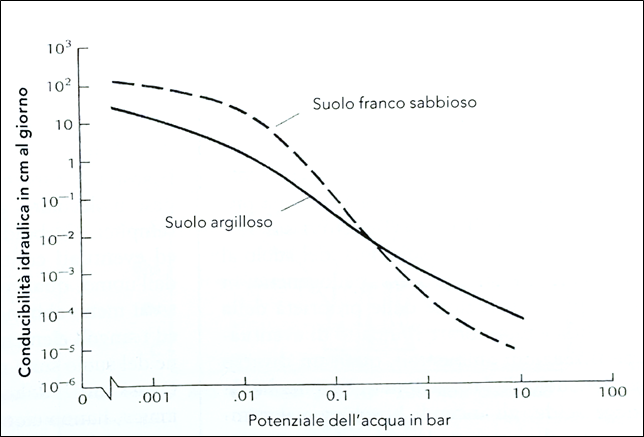To maintain a proper balance in the water-soil-plant system, it is also essential to know the hydrological properties of the soil and, among them, its ability to retain water (water potential). Water, in fact, within the soil is not free but is involved in a series of forces for which the plant must perform work in order to obtain its needs.
There is a relationship between the water potential of the soil and the water content within it. This relationship is expressed through the water retention curve: using specific pressure forces, it is possible, in fact, to know the water content at different values of potential. According to the chemical and physical characteristics of the soil (organic matter content, aggregate structure, macroporosity and microporosity) different water retention curves will result (Fig. 1). In addition, we know well how poor soil management can lead to problems of compaction, destruction of aggregates, reduction of the organic component, resulting in drainage and water retention difficulties.

Fig. 1 – Water retention curves of a clay and a sandy loam soil. Modified from Brady (1984). (from Basics of Pedology, G. Certini and F.C. Ugolini, 2021)
By convention, hydrological constants are used to characterize the capacity of a soil to retain water: specifically, from the field capacity (FC) and the permanent wilting point (PWP) we can obtain an additional hydrological constant, which is theavailable water (AWC) for plants. The field capacity (FC) is the amount of water that can be retained by capillarity against the action of gravity forces, while the permanent wilting point (PWP) is the soil water content at which plants irreversibly wilt. In addition to the hydrological characteristics of the soil, it is also possible to obtain additional information involving total porosity and air capacity by measuring the saturation point.
Within the Timesis laboratory, it is possible to make such measurements through the use of specific instrumentation such as the Stackman’s tank (Fig. 2) and the ‘Richards’ plates’ pressure extractor (Fig. 3) of two types: plate and membrane. The extractor is a special pressure chamber equipped with a cellulose membrane that lets water, but not air, filter through its pores so that a constant pressure is maintained inside. Such instruments allow measurements to be taken from the point of saturation (0 bar) to the point of permanent wilting (15 bar). Proper sampling of undisturbed soil, with the cylinder of known volume, is required upstream of the measurements.

Fig. 2 – Stackman tank and soil samples of known volume.

Fig. 3-Pressure plate extractor (Richards’ Plates).
How to perform extraction: a practical guide
Information and quotes
For any other information and quotes, you can contact us at timesis@timesis.it

